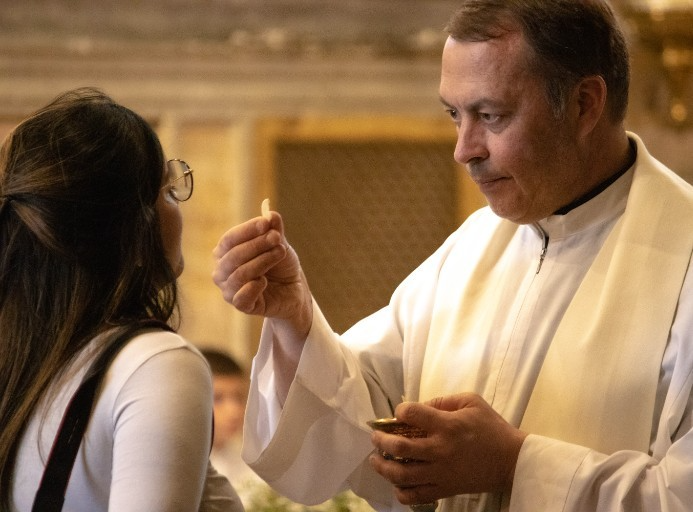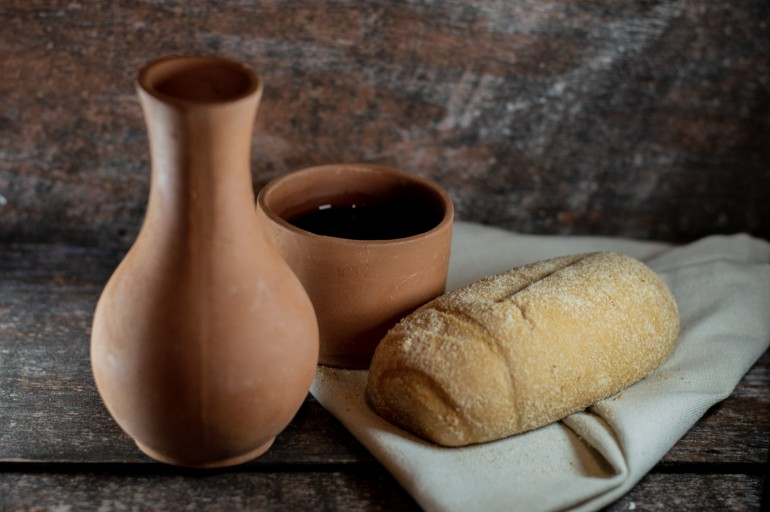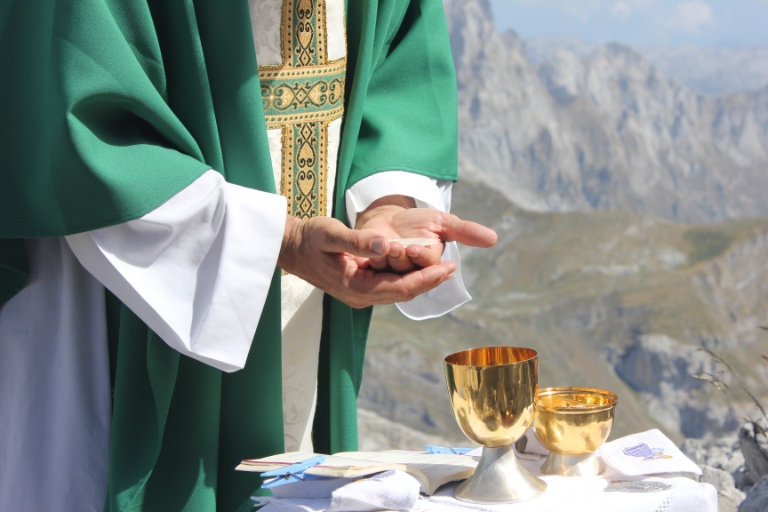A conversation on Jesus, and the Eucharist, as the bread of life
The events across many parts of the USA following the hurricane in early August 2024 prompted me to reconsider my appreciation for a humble staple: bread. Bread has never been my go-to food, yet each time I indulge, it tastes surprisingly delightful. However, the hurricane, which toppled trees and downed power lines in my neighborhood, has left us in a blackout expected to last up to a week. This situation has forced me to rethink my grocery list and include more bread to survive without the luxury of refrigeration.
As I navigate the choices between rye, white, brown, and the myriad of bread types in a typical US grocery store, I begin to reflect on the symbolism of bread, both in general and within our Catholic faith. The Eucharist, a central sacrament in our faith, is a ritual reenactment of the Last Supper, where bread and wine are consecrated and consumed as the body and blood of Christ.
Bread appears about 395 times in the Old Testament and 97 times in the New Testament, totaling 492 mentions. In comparison, wine, the second most referenced food item, appears about 231 times. Why does the Bible place such emphasis on bread? What is the deeper meaning behind the Lord’s declaration, “I am the bread of life,” as we delve into the richness of the Eucharist, the source and summit of our spiritual life as Christians? (Lumen Gentium, 11; Catechism of the Catholic Church, #1324).
Reflecting on the Journey to Capernaum
Reflecting on past meditations, I consider how, after feeding the five thousand, the Lord left the western shore of Galilee, also called the Sea of Tiberias, and crossed to Capernaum. As He continued the Father’s work, many who received the miracle followed Him across the sea (John 6:24). The seed of faith had already been planted in their hearts. They began to warm up to Christ. Their intentions may not have been perfect, but their desire was an essential step in the life of faith.
Jesus as the Bread of Life
Now, the Lord Jesus takes their expressed desire and presents the audience with what they truly need, despite their different understanding of what they seek. Jesus declares, “I am the bread of life; whoever comes to me shall not hunger, and whoever believes in me shall never thirst” (John 6:35).
This bold claim unsettles the listeners. They came to satisfy physical hunger, but this humble Nazarene offers an entirely different nourishment. It’s like a child wants something, and the parents offer something else. Should the seeker accept or not accept?

Jesus doubles down on the claim and states His eternal relationship with the Father and how His will aligns with the Father’s will, including His mission to save those who believe and grant them eternal life (John 6:36-40).
This claim is challenging for the audience to accept, just as it is for more than 75% of US Catholics who, according to a Pew Research Center survey of 2019, think the Eucharist is merely symbolic of Jesus’ body and blood. Many Christians see the Eucharist as a communal sharing without recognizing the real presence of Christ’s body and soul.
The Living Bread from Heaven
The listeners in this passage have similar doubts, questioning the metaphysical equivalency between Jesus being the bread that came down from heaven and their understanding of the manna God provided their ancestors in the Old Testament. Jesus must not and should not compare himself to the manna experience, they argue. That would be sacrilegious.
They do not realize that Jesus is not comparing Himself to manna but asserting that He has the power to come down from heaven (John 6:41-51). These doubts and questions are not uncommon, and they provide an opportunity for us to penetrate the mystery of the Eucharist and its significance in our faith.
Jesus further radicalizes this claim by stating, “I am the living bread that came down from heaven” (John 6:51). He aims to remove all doubts from His listeners’ minds. He is far beyond their view of the manna, which is perishable, while He is not. The manna does not have the power within itself to grant life or nourishment. He, Jesus, does.
The Idea of Bread as Noise and Distraction
There is often noise about Jesus and the Eucharistic mystery in our minds and hearts. The noise increases as we contemplate what bread feels like, its various flavors, and the delicious aroma as it comes fresh from the oven. The pleasant presentations and fresh yeastiness of bread are wired in our neurons, leading us to think of physical bread and its various meanings.

Culturally, bread is seen as a staple of life, symbolizing sustenance, as noted by the Encyclopedia of Food and Culture (2003). Literature about bread often embodies the nurturing of body, not realistically but as an aesthetic taste. Socially, bread signifies community and sharing, a metaphor for fellowship, as highlighted by The Oxford Companion to Food (1999).
Biblically, bread represents sacrifice and offering, such as the showbread in the Tabernacle (Leviticus 24:5-9), as explained by The New Interpreter’s Dictionary of the Bible (2009). Additionally, bread symbolizes the cycle of life and death, as Jesus refers to Himself as the “bread of life” (John 6:35), a concept explored in The Dictionary of Biblical Imagery (1998). The Eucharist, as a communal sharing of the body and blood of Christ, further reinforces this sense of community and fellowship in our faith. But all these need to dig deeper into what Jesus means here. The above biblical texts and many others as we shall see provide clues.
Transcending the Common Understanding of Bread
Jesus emphasizes that the meaning transcends our common understanding when He speaks of bread. Robertson (1933) explains that Jesus is “the bread of life in two senses: it has life in itself, the living bread (John 6:51), and it gives life to others, like the water of life, the tree of life.” It means that Jesus, as bread, possesses life and imparts life. Unlike ordinary bread that decays without refrigeration, this bread knows no decay or corruption. It is life-giving. By declaring Himself as the living bread, Jesus connects the bread metaphor to the reality of life—”He is life itself. Anyone who partakes of Him gains life. It is this sense we see the Church reflect in her summary in Catechism of the Catholic Church (CCC 1333-1334).

Jesus, as the living bread, not only sustains life but also empowers those who receive Him to bear fruit. Believers become channels of life to many, birthing evangelization as a witness to the life-giving grace of Christ, who is the way, the truth, and the life (John 14:6).
The gradual revelation of this truth in John 6, from addressing physical needs to emotional, neurological, moral, and ethical needs, and finally to deeper theological and spiritual needs, is profound. It’s as if Jesus lets out crumbs of understanding, piece by piece, as His audience grapples with what the Lord says truly mean. When they reach a point of deadlock, He breaks the silence with yet another layer of understanding. The approach, as described, is how He reveals the truth of the faith gradually but powerfully.
Overcoming Doubts About the Eucharist
“Do not murmur,” the Lord says, reminding us not to be frustrated when this “bread” does not solve all our human problems, beginning with doubt. Or when we are overly familiar with the rituals, the elements, where the host is baked and purchased, or the wine produced in our local wineries. What does it mean that with simple ritual gestures and words, these flour and fermented grapes become Jesus, the Lord who came down from heaven? Unacceptable.
But Jesus does not let us remain in doubt. He intervenes again, saying, “Truly, truly, I say to you, whoever believes has eternal life” (John 6:47). “I am the living bread that came down from heaven; if anyone eats of this bread, he will live forever; and the bread that I will give for the life of the world is my flesh” (John 6:51).
There it is. To dispel doubt, Jesus moves beyond metaphorical language to a more vivid expression: ”the bread I give is my flesh.” Flesh is alive and embodies life. By doing so, He connects this discussion to His sacrifice on the cross, where His flesh and blood are poured out for the life of the world. This very mystery is what we celebrate daily in the Eucharist.
What would faith in this truth of Jesus as the bread of life mean? Saint Augustine and many Fathers of the Church provide us with answers, and the Church has left us rich resources to glean the truth of these claims. I’d expand on this theme next week.